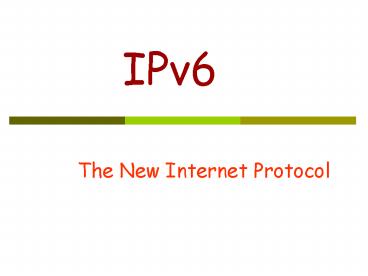IPv6 - PowerPoint PPT Presentation
1 / 21
Title: IPv6
1
IPv6
- The New Internet Protocol
2
The Design of IPv6
- IPv4 design was very good IPv6 should keep most
of it - It could only increase the size of addresses and
keep every thing the same - Experience brought lessons for improvement
3
IPv6 Header (40 bytes)
0
31
16
128 bits
40 bytes
128 bits
4
IPv4 Header (20 bytes)
0
31
16
Version
Hd len
Tot len
ToS
identification
DF MF
Fragment offset
protocol
Hd chksum
TTL
Source Address
20 bytes
32 bits
Destination Address
32 bits
Options (if any)
5
- while
- the IPV6 address are four times as large as the
IPV4 address, - the header length is only twice
- as big.
6
Notations of IPv6 Addresses
- 128 bit is represented as
- Eight 16-bit parts, separated by colons,
- each part is represented by 4 hex digits
Example FEDCBA9876543210FEDCBA987664
3210
7
Simplifications
- Skip leading zeros
- Example108000000000000000080800200C417A
- is reduced to 10800008800200C417A
- A set of consecutive nulls is replaced by
(at most one inside an address) - the above address is reduced to
- 10808800200C417A
8
Comparison of Headers
- V6 6 fields 2 addr
- V4 10 fields 2 addr options
- Deleted
- Header length
- type of service
- identification, flags, fragment offset
- Header Checksum
- Added
- Priority
- Flow label
- Renamed
- length -gt Payload length
- Protocol -gt Next header
- time to live -gt Hop Limit
- Redefined Option mechanism
9
Simplifications
- Fixed format headers
- no options -gt no need for header length
- options expressed as Extension headers
- No header checksum
- reduce cost of header processing, no checksum
updates at each router - minimal risk as encapsulation of media access
protocols (e.g..., Ethernet, PPP) have checksum - No segmentation
- hosts should use path MTU discovery
- otherwise use the minimum MTU (536 bytes)
10
Renaming
- Total Length ? Payload Length
- not include header length
- max length 64Kbytes with provision for larger
packets using jumbo gram option - Protocol Type ? Next header, can be set
to - Protocol type (UDP,TCP, etc..)
- Type of first extension header
- TTL ? Hop limit
- Truth in advertising!,
- number of hops NOT number of seconds
11
New Fields
- Flow label Priority
- to facilitate the handling of real time traffic
12
Options ? Extension Headers
- Routers treats packets with options as
second class citizens - because it is slow to process,
- thus programmers tend not use them and options
almost became obsolete.
13
IPv6 extension headers
- Hop-by-hop options
- Routing
- Fragment
- Destination options
- Authentication
- Encryption Security Payload
14
ICMP. Streamlined
- Removed unused functions in ICMP of v4
- Incorporate IGMP of v4
15
ICMP Error Messages
1 Destination Unreachable. Codes 0
No route to destination 1 destination
prohibited 3 Address unreachable
4 Port unreachable 2 Packet Too Big
contain next hop MTU. used for path MTU
discovery 3 Time Exceeded. Codes 0
Hop limit exceeded 1 Fragment reassebly
time exceed 4 Parameter Problem
16
Other ICMP messages
128 Echo Request 129 Echo Reply 130
Group Membership Query 131 Group
Membership Report 132 Group Membership
Termination 133 Router Solicitation 134
Router Advertisement 135 Neighbor
Solicitation 136 Neighbor Advertisement 137
Redirect
17
(No Transcript)
18
Points of Controversy
- Do we need more than 255 Hops?
- allowing hop count to be very large, looping
packets will be relayed many times before being
discarded - Should packets be larger than 64K?
- allowing very large packets increase the size of
queues and the variability of queuing delays - Can we live without checksum?
- Some IPv4 routers started to cut corners by not
verifying checksums to gain advantage over
competition. By removing checksum altogether
offers all routers the same advantage.
19
Real-time Support Flows
- A proper handling of flows is required for
high-quality multimedia communications in the new
Internet - A flow is a sequence of packets sent from a
particular source to a particular (unicast or
multicast) destination for which the source
desires special handling by the intervening
routers.
20
Transitioning the Internet
- At the beginning, all IPv6-capable hosts will
also be IPv4-capable so as to retain connectivity
with the existing Internet. - To transform IPv4 into a dual-stack
IPv6-capable host, it should include - The IPv6 basic code
- Handling IPv6 within TCP UDP
- Modify socket interface to support new addresses
- Handling the interface with the name service
21
The 6-Bone
- The Similar to the M-Bone, Initially the
connectivity is achieved by tunneling - IPv6 packet will be encapsulated within IPv4
packets.































